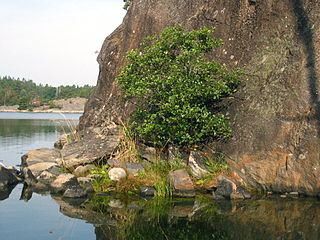The Alder Tree
What can no house ever contain?Answer: The piles upon which it is built.This riddle refers to the alder wood base that ancient houses were built upon, before the concrete cinder blocks or stone-and-mortar that are used today. Alder was the preferred wood because it is resistant to water decay.Alder is considered a core magical tree. It corresponds to the letter Fearn of the Irish Ogham alphabet and to the rune Isa. It is sacred to the Greek goddesses Circe and Calypso.In Finnish the word for alder is derived from a word meaning “blood,” which refers to the red sap the tree oozes when cut. Red pigment from the bark was once used as a dye and a face paint. There is an old superstition against cutting down the alder tree, ostensibly because it “bleeds.” This seems to me a strange rationale, since a pig or any other edible animal also bleeds when killed. However, there are ecological reasons for leaving a stand of alder trees unmolested in certain cases, since the alder is an important pioneer species, fixing nitrogen to the soil in marginal growing areas.In some stories the Black Alder is substituted for the Black Poplar. For example, in the myth of the Greek sun god Phaeton, the god’s sisters turn to poplars at his death in one version and to alders in another. Substitutions such as this can give a clue as to the magical properties of the tree. Both the Black Alder and the Black Poplar grow in wet soil or along riverbanks. They are also pioneer species, meaning they are early volunteers on cleared land or nutrient poor soils. The riverbank association would link the alder with death, while the pioneer aspect evokes the concept of resurrection. (For a discussion of the relationship of rivers with death see Hecate and the Waterway.)The death aspect is unmistakable with the lovely goddess Calypso, who has a thicket of alder, poplar and cypress growing at the entrance to her island cavern. Calypso amuses herself pulling drowning sailors from the sea and taking them to her love cave. In the mythology of Greece, Scandinavia, Britain, and Ireland, islands are otherworld places where the dead are received or where magical events occur. The Greek goddess Circe, who transforms men into animals, has a ring of alder trees surrounding her island.Bran the Blessed, who carries an alder branch, is certainly associated with death and resurrection. The giant king gives his Irish in-laws a magic cauldron as a peace offering, a cauldron which brings to life any dead thing that is put inside it. Bran repents of his gift when he goes to war against the Irish, because they revive their dead warriors with the cauldron. When Bran later dies, he tells his comrades to cut off his head. This in itself is not unusual, as the Celts often brought home the heads of their fallen heroes when for some reason they could not bring the whole body. But the disembodied head of Bran is rather remarkable. For the next 87 years it recites poetry, performs divination, and tells stories from the past, serving as a bridge between the otherworld and the land of the living.The fairies bring another link between the alder and magic by virtue of their own otherworld connection. Green is the color usually worn by fairies, and they are said to dye their clothing from the immature alder catkins, which produce a green pigment. Of course, the red pigment from the bark would link the alder tree to the blood of the womb, often represented by the cauldron, a symbol of death and rebirth.SourcesBasic RunesGraves, Robert. The Greek Myths. London: Penguin, 1960.Graves, Robert. The White Goddess. New York: Farrar, Straus and Giroux, 1948.Hybrid PoplarLefevre, Francois, Agnès Légionnet, Sven de Vries Jozef Turok. Strategies for the conservation of a pioneer tree species, Populus nigra L., in Europe, 1998.Monaghan, Patricia. The Encyclopedia of Celtic Mythology and Folklore. New York: Checkmark Books, 2008.Walker, Barbara. The Woman’s Dictionary of Symbols and Sacred Objects. San Francisco: Harper and Row, 1988.Woodland Trust. Common Alder.


Thank you for sharing – that was so interesting!
This was a very good read. I know this tree but did not know all of this history about the Alder. The path I take on rides and walks has quite a few Alder trees lining it near where the small farm streams gather. It is a very charming tree. For years I have collected the little male catkins that look like tiny pine cones when they turn brown. I’ve felt encouraged to pick them up and felt them protective. A few always sit on my drying board.
Thank you for sharing this.
So interesting! Thank you.